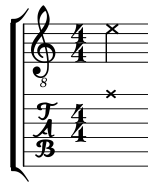Ghost note

In
On
Instrumental music
Ghost notes are not simply the unaccented notes in a pattern. The unaccented notes in such a pattern as a clave are considered to represent the mean level of emphasis—they are neither absolutely emphasized nor unemphasized. If one further deemphasizes one of these unaccented notes to the same or a similar extent to which the accented notes in the pattern are emphasized, then one has 'ghosted' that note. In a case in which a ghost note is deemphasized to the point of silence, that note then represents a rhythmic placeholder in much the same way as does a rest. This can be a very fine distinction, and the ability of an instrumentalist to differentiate between what is a ghost note and what is a rest is governed largely by the acoustic nature of the instrument.
A frequent misconception is that grace notes and ghost notes are synonymous. A grace note is by definition decidedly shorter in length than the principal note which it 'graces', but in many examples the grace note receives a greater degree of accentuation (emphasis) than the principal itself, even though it is a much shorter note than the principal. In other words, while a grace note could be ghosted, the ghosting of notes is a function of volume[citation needed] rather than of duration.
Percussion

In drumming, a ghost note is played at very low volume,
The term ghost note, then, can have various meanings. The term
- slightly softer than surrounding notes: ◡ (breve)
- significantly softer than surrounding notes: ( ) (note head in parentheses)
- much softer than surrounding notes: [ ] (note head in square brackets)
Examples can be heard in the drumming of
Stringed instruments

A guitarist wishing to ghost a note can decrease the pressure the fretting hand is exerting upon the strings without removing the hand from the fretboard (which would result in the sounding of the open pitches of those strings). This is sometimes called a 'scratch', and is considered a ghost note unless all the unaccented notes in the pattern were 'scratched' (in which case the scratches are unaccented notes).
On the
Bassists James Jamerson (of Motown), Carol Kaye (of Motown), Rocco Prestia (for Tower of Power), and Chuck Rainey (for Steely Dan, Aretha Franklin, and others) all include "tons of ghost notes done right" in their playing.[3]
Vocal music
In vocal music, especially in
As an extreme example, the opening number of The Music Man, "Rock Island", is written almost exclusively in ghost notes.
This notation may also indicate Sprechstimme or rapping.
See also
References
- ^ "Jazz Glossary: ghost note". ccnmtl.columbia.edu. Retrieved 30 April 2023.
- ^ " False note", OnMusic Dictionary.
- ^ ISBN 978-1-4234-3138-1.
- ^ ISBN 1-4234-0818-7.
- ISBN 9781576235225.
- ^ ISBN 9781884365324.
- ^ Gianni, Jason (2003) The Drummer's Bible: How to Play Every Drum Style from Afro-Cuban to Zydeco, p. 35. See Sharp Press. "Purdie Shuffle" At Google Books. Retrieved 11 May 2013.
- ISBN 978-0-471-79411-0.
- ^ "Living Legend Tries to Make a Living". New York Times. March 29, 2011. Archived from the original on April 6, 2011. Retrieved November 20, 2015.
- ISBN 9789825320043.
